“Where is the bathroom?” I asked the girl who showed me a room in her guesthouse. She had a beautiful room with lot of space and a thick bed with colourful sheets on it. The insides were sparsely furnished, but whatever existed was tastefully decorated with a dash of traditional Ladakhi paintings. I loved the place and would have been happy to stay there for the next five days of my stay at Korzok Village. But her face fell the moment when I asked her about bathroom. “No bathroom,” she said and led me down the stairs. Pointing to a steel basin and a vessel full of water on the ground, she helpfully indicated that we can wash our hands and face there, but there aren’t any bathrooms.
I wasn’t exactly ready to stay in a room with no bathing facilities, but had anticipated for guesthouses to not have bathrooms. At Pangong Lake only a few days ago, a home-stay owner had shrugged when we asked for a bathroom and pointed in the direction of the lake. We were finally lucky to find a place with a bath at Pangong. But here in Korzok Village deeper inside Changthang Plateau, where our options of accommodation were a choice of expensive luxury tents and basic guesthouses, I wasn’t sure if there was something of a compromise between the two that offered a place to wash ourselves.
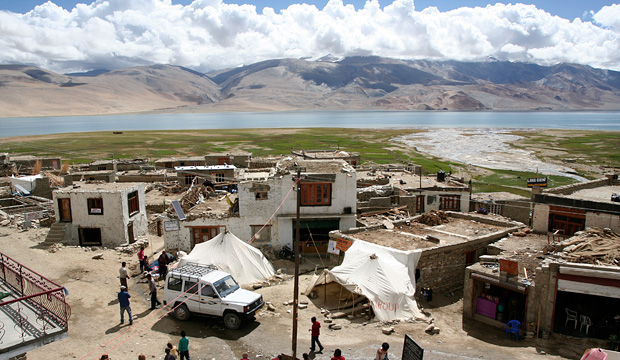
Korzok Village
Changspa (chanspa, chang pa), the people of Changthang, do not exactly think freshening up everyday is one of their priorities. The winter here is so harsh that temperatures dip below -30C, while summer is a terribly busy season when they spend every second of waking time busy working. In a place where there is no plumbing, no running water and no electricity, a bath is a great effort and doesn’t figure high in the list of things to do. And when you have a 12,000 hectare deep blue lake only a stone’s throw away from where you live, you don’t really need a bathroom for that once-in-a-while bathing ceremony.
But spending four days without bath was not exactly something I fancied. Every other house in Korzok has a ‘home-stay’ sign hanging in front of it, but not too many of them came with bathrooms. We must have spent a good thirty minutes before finding one that fit the bill – a simple room with a washroom.
Earlier in the day, we had started from Leh early in the morning, making the long and monotonous journey upstream Indus to Tso Moriri. Passing through now-familiar road that took us till Upshi, where a road deviated towards Manali, we drove further upstream where the river becomes narrow and swift, while the mountain slopes became steeper. Good roads allowed us to cover the distance quickly as we passed through barren landscapes and occasional villages with a dash of greenery around them. Stopping at Chumathang briefly for a cup of tea we did not want to drink next to a hot-spring that we did not want to see, we continued towards Mahe Bridge, where the road cuts across Indus and enters the Changthang Plateau.
Passing through Tso Kiagar, a small lake that we see an hour before, we arrived at Tso Moriri at 2pm to see a large expanse of superb blue colours of the lake, its other end far enough to be not visible. Our road skirted the lake shore, where a bar headed geese drifted gently in the waters, tailed by its five inquisitive chicks. Korzok Village was visible a few kilometers away, located on a slope just above the lake.
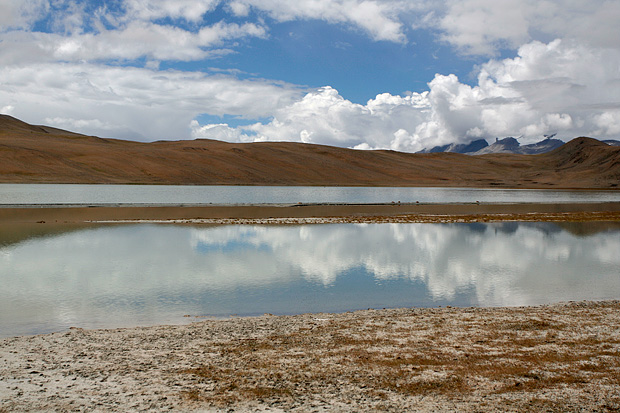
Tso Kiagar Lake
Korzok is a small village with perhaps fifty families living on the bank of Tso Moriri. As in every Ldakhi Village, a monastery and a bunch of haphazard chortens higher up the slopes dominated the village. The place looked like work-in-progress, akin to our larger cities, with lot of construction in progress either to modernize their dwellings or to build more accommodation for tourists. At 225km from Leh, Korzok is far from any large town and is yet to see modern facilities like electricity and regular public transport. The approach to the village is getting better by the years and a tarmac road now ends just half an hour before the village. It would be a matter of few years before the village gets to inhale the first smell of tarmac.
I spent the first day at Korzok lazing in the room and staring at the lake from my window for a few hours and then sauntering in the village in the evening hours. The next few days were to be spent exploring the village, watching a monastic festival and visiting the nomad herders of changthang plateau.
+ Also see: Drive from Leh to Tso Moriri and conversations with driver Rigchen
+ Map of Korzok Village and places on the way from Leh to Tso Moriri.
View Leh to Tso Moriri in a larger map
Here is a list of all the posts on Pangong Lake. As you can see, this one is really big on the journey than destination!
1. Hiring a Bullet Thunderbird and heading to Panong Lake, climbing over Chang La
2. Descending Chang La and seeing a beautiful lake on the way
3. Trouble with the bike and getting helped by strangers
4. Crossing the troublesome pagal nala on the way
5. Pangong Lake
6. Spangmik Village on the bank of Pangong Lake
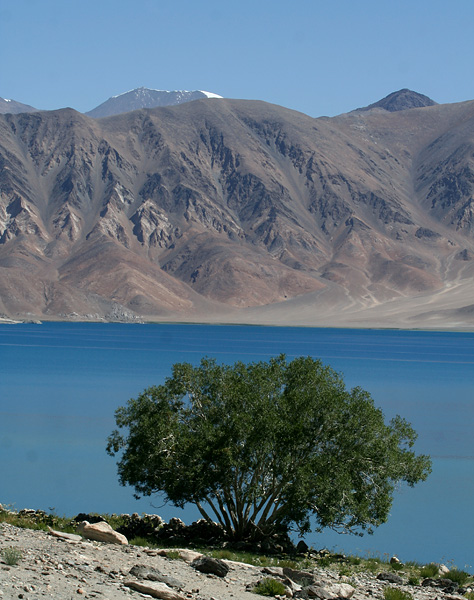
Spangmik is as remote that a village can get but still remains accessible by road. It is almost like being at the edge of the world. A small army check-post bars civilians from going any further towards the border of Tibet. The mountains faraway cause an intrigue generated by lack on information on this sensitive region, making me wonder how the terrain at the other end of the lake would be.
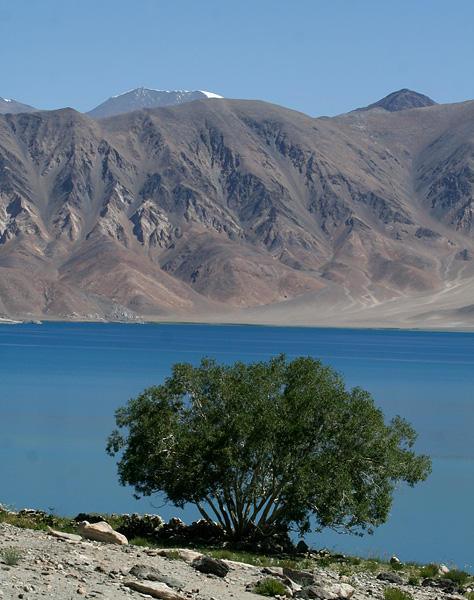
Pangong Lake
The village is located on a narrow stretch of land between the mountains and the lake, with just seven families that make a living by rearing pashmina goats and growing barley during the short summer season. These days, some families rent out a room or two for tourists while a few others work with hotels coming up in the area. Summer is a busy season where a lot of things have to be done together – tending the fields, looking after tourists, taking the goats out for grazing and collecting all necessary resources for a long winter.
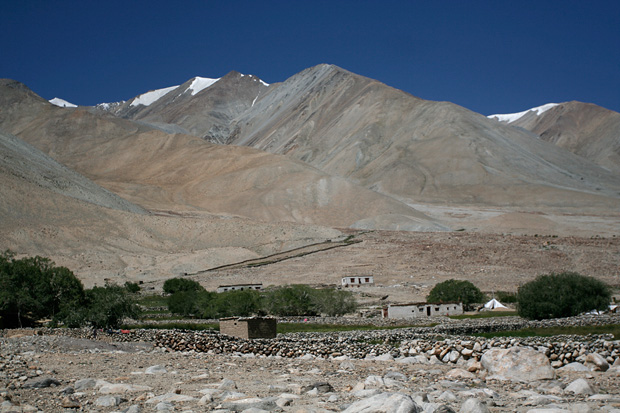
Spangmik Village and the mountain peaks.
Kunchok, the caretaker at our guesthouse gave me some insights to life at Spangmik through the year. He tells me that they grow barley in summer, but not much crop can be extracted from the earth here. Every family owns a few dozen pashmina goats that generate most of their income. “Traders come from all over North India to buy wool of pashmia goats,” he says, “we recently had someone coming from UP.” The wool is sent to Kashmir and Himachal where it is woven into fine cashmere shawls, to be sold all over the world.
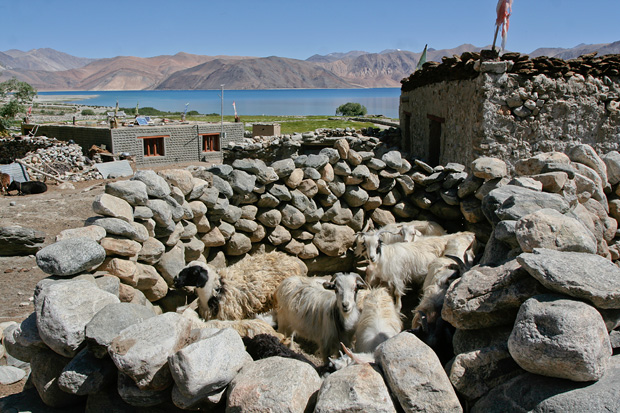
The Pashmimna Goats, Spangmik Village and Paangong Lake.
Most of the activity in Spangmik happens in summer, while winters are months to be spent doing very little work. It is a time when the weather is harsh, the land is snowbound and the lake is frozen. “There isn’t much to do during the cold days,” Kumchok tells me, “we will spend most of our days staying indoors.” But still, they are not the days spent completely idling. The sheep have to be taken care of and the meals have to be cooked, which is a lot of work in itself when you don’t have too many resources at hand. But compared to the busy summers when there is simply too much to do, they have a lot of free time in the cold days.
Unlike many parts of Ladakh that get cut off during the winter months, Spangmik remains connected with Leh by road through the year. “The road through Chang La remains open,” says Kunchok, “we are very close to the border. So, Indian Army ensures that this place is always accessible.” The sensitive border needs to be monitored continuously despite the difficult conditions in winter. “Not many people come here during winter,” Kunchok continues, “but a few tourists do turn up once in a while. The lake will be frozen solid and people even drive their cars on it.”
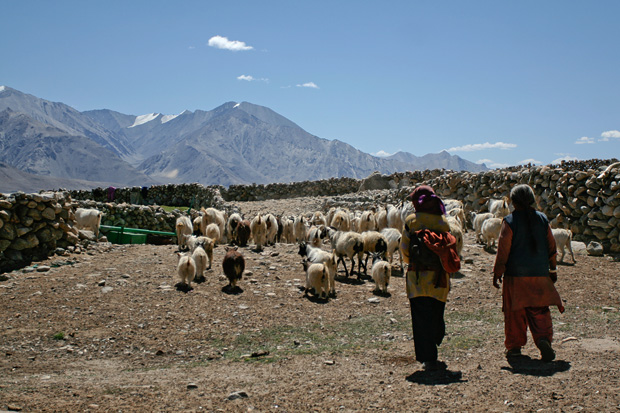
Herding the Pashmina Goats
One of the mornings when I was at Spangmik, I went for a walk in the village to take a look at the goats. They stay confined to small enclosures during the nights and are herded out to the pastures for grazing in the day. They rush out when the gates are opened in the morning, eager to get out and feed through the day. It is a bit of chaos as they run around looking for whatever little grass nearby, but an order is restored very quickly and they march in unison towards the mountains, driven by their herders. I felt an urge to go with them and spend the day in the pastures, but I have only three days in Pangong that I prefer to spend ambling near the lake.
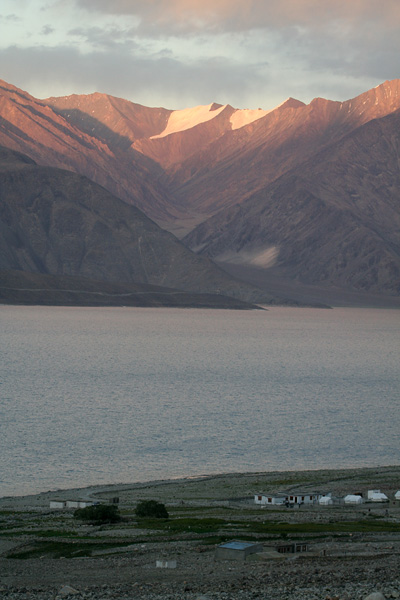
Spangmik Village and Pangong Lake during sunset.
Although I did not make it into the hills with the goat herders, one evening I climbed up one of the lake-facing slopes to the dwelling of a lama who lived alone in a small hut. Unlike many places in Ladakh, Spangmik doesn’t boast of a monastery of its own. The population here is too small to establish and sustain a monastery, but the lama takes care of spiritual needs of the villagers. It is an hour long climb on a gentle slope along a pebble-ridden path crisscrossed by many streams. Once at the top, I was hoping to get a panoramic view of the lake, but the hills closer to the lake limit our views on either side. Yet, it is a different perspective seeing the lake from high up and getting a feel of the scale of the landscape around us.
The remoteness of Spangmik is all the more evident when seen from my high vantage point. The few houses are scattered like dots in a landscape dominated by the long blue stretch of the lake and the barren mountain slopes. It looks like a place out of dreams that is too unreal and too beautiful to be true.
Our three days in Spangmik seemed too short a time to get a good feel of the place. The peace of Spangmik takes a few days to set in and become a part of our system. The peace of the village can slowly let the complicated problems of a larger world go away and have a calm influence over mind and body. But the lure of new things, new places and a desire to be everywhere is hard to resist. A monastic festival at another lake-side village was a temptation that could not be resisted. We left Spangmik, this time not taking the trouble of treading across Pagal Nala, but simply loading the bike on a Gypsy and getting it across the troublesome channel.







